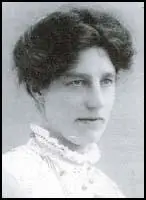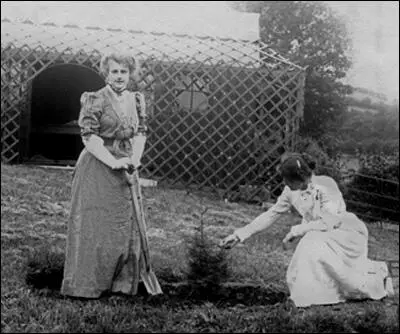Marie Brackenbury

Marie Brackenbury, the daughter of Hilda Brackenbury, and the sister of Georgina Brackenbury, was born on 15th October 1866. Her father, Charles Brackenbury, was an army general and two of her brothers died while serving in the armed forces.
Brackenbury studied at the Slade Art School and became a talented landscape painter. A member of the National Union of Women's Suffrage Societies (NUWSS) she joined the Women's Social and Political Union (WSPU) in March 1907. Marie later recalled that she had been impressed with the "womanliness" of Emmeline Pankhurst.
In February 1908, Marie Brackenbury and her sister Georgina Brackenbury were arrested in February 1908 during a WSPU demonstration outside the House of Commons and was sentenced to six weeks in Holloway Prison. Later that year she contributed a cartoon to the Woman's Franchise journal.
Marie visited Eagle House near Batheaston on 22nd July 1910 with her sister Georgina Brackenbury. Their host, was Mary Blathwayt, a fellow member of the WSPU. Her father Colonel Linley Blathwayt planted a tree, a Cupressus Lawsoniana Filifera, in her honour in his suffragette arboretum in a field adjacent to the house.

Christabel Pankhurst decided that the WSPU needed to intensify its window-breaking campaign. On 1st March, 1912, a group of suffragettes volunteered to take action in the West End of London. The Daily Graphic reported the following day: "The West End of London last night was the scene of an unexampled outrage on the part of militant suffragists.... Bands of women paraded Regent Street, Piccadilly, the Strand, Oxford Street and Bond Street, smashing windows with stones and hammers."
Marie Brackenbury and her mother, were both arrested for taking part in the demonstration. Hilda Brackenbury, aged 79, was accused of breaking two windows in the United Service Institution in Whitehall. She served eight days on remand before being sentenced to 14 days in Holloway Prison. In court Marie claimed that she was "a soldier in this great cause". She was sentenced to two weeks in prison.
Mrs Brackenbury's home at 2 Campden Hill Square, London, became known as "Mouse Castle" as members of the WSPU went there to recuperate after being released under the Cat & Mouse Act.
Marie Brackenbury died in 1950. The last survivor of the immediate family, she left the house to the Over Thirties Association. The Suffragette Fellowship commissioned a plaque to be attached to the house. It read "The Brackenbury trio were so whole-hearted and helpful during all the early strenuously years of the militant suffrage movement. We remember them with honour."

